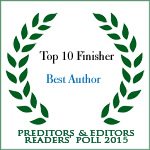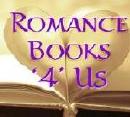
 Before I begin today’s installment of my 2016 Symbol Series, I’d like to share some fantastic news. Madeline Archer, my alter ego won the coveted Predators & Editors Top 10 Reader’s Poll for Best Author of 2015! Not only that, Entice Me and Exquisite Christmas (the multi-author anthologies I assembled and saw to print) won two spots in the Top 10 Best Anthologies. I’m tickled pink and very proud.
Before I begin today’s installment of my 2016 Symbol Series, I’d like to share some fantastic news. Madeline Archer, my alter ego won the coveted Predators & Editors Top 10 Reader’s Poll for Best Author of 2015! Not only that, Entice Me and Exquisite Christmas (the multi-author anthologies I assembled and saw to print) won two spots in the Top 10 Best Anthologies. I’m tickled pink and very proud.
 Now I’d like to share an old shame. Back in my high school days I contacted an organization that got books on tape into the hands of the visually impaired. I wanted a specific book, but formats like this weren’t available in bookstores. This was the age of the 8-Track so I figured that’s what I’d get. I had no idea books on tape were really books on reels. It turned out they didn’t have my particular book on a reel, not that I could even play a reel if they had.
Now I’d like to share an old shame. Back in my high school days I contacted an organization that got books on tape into the hands of the visually impaired. I wanted a specific book, but formats like this weren’t available in bookstores. This was the age of the 8-Track so I figured that’s what I’d get. I had no idea books on tape were really books on reels. It turned out they didn’t have my particular book on a reel, not that I could even play a reel if they had.
Assuming I was visually impaired, they offered me braille instead. They also said as the book was a short one, they could also have someone schedule to read to me over the phone. Read to me? To be honest, there was a split second where I considered it, but someone in real need would go without. Feeling sheepish and ashamed of myself, I thanked them for their generous offer and declined. What book could possibly lead me down the dark path of chicanery? The Great Gatsby.
Don’t laugh!
At the time that book was a necessary evil. A thorn in my side. A pebble in my shoe. It was required reading in my English class and I hated it. From the very beginning that story grated on me. I’d find myself reading and rereading the same miserable paragraphs over and over. My brain just couldn’t get into the crazy writing. I mean really, a city divided into East Egg and West Egg? City = Eggs? Who writes like that?? I had no form of reference and a very young and new English teacher who might have explained the concepts better. Let’s just say I wanted to punch ol’ F. Scot Fitzgerald in the nose.
There’s no doubt symbolism in literature creatively enhances the storytelling. But using it like F. Scott Fitzgerald is akin to someone delivering the punchline to a joke and expecting you to instinctively know what the set-up was. After seeing a movie made of the darn book many years later, I came to understand the author’s most dumbfounding metaphoric lines were symbols for concepts. Example: Doctor T. J. Eckleburg’s eyes looking down on the world. Those fading, bespectacled eyes were a metaphor for divine judgement in George’s mind. ::sigh:: Out of all of it, the metaphor that made the most sense was how the weather tied in to everything Daisy Buchanan did or felt. That much was easy.
This week’s portion of the 2016 Symbol Series starts with a hodgepodge of things deliberately used to stand in for a thought. But first, how about that record-breaking weather in the Mid-Atlantic? In the Great Gatsby, Daisey Buchanan forever had a cloud or sunbeam on her frame of mind. Weather symbolized the overall mood. Authors will often use weather and natural phenomenon to convey all sorts of details. I’ve done so more than once. Have you?
Here are a few symbols from the earth and the elements:
Air ~ German Philosopher Nietzsche thought of air as man’s freedom. His writings often refer to air in one form or another (lots of flying through air in Nietzsche’s mind). Shakespeare too used air as a symbol of thought. As breathing creatures, we rely upon air. Now with breathing and thought in mind, how powerful a metaphor is it to have “air” taken away?
Wind ~ Gentle breezes and ill winds generally act as portents signifying that change is on the way. Wind is fleeting and transient. The wind reference often comes in the form of billowing sails that may represent adversity unless a new course is charted. Then it takes on a role of potentiality. If you really want to see wind used to convey a thought, read John Steinbeck’s The Grapes of Wrath.
Dawn ~ Almost always a symbol of awakening. The coming of light is seen as a resurrection. A new day is a second chance.
Night ~ Often associated with secrecy and things hidden under darkness. It can be the flip-side to dawn. Instead of enlightenment, you get ignorance. Nightfall also has sexual and death associations.
Sky ~ The sky broadly represents eternity and references vastness and unlimited possibilities. It also symbolizes heaven and the universe.
Earth ~ Generally a reference for stability and foundation for life. We see “earthy” references that hint at the robust, lusty, or uninhibited. Often used for unrefined, basic, coarse, or crude.
Clouds, fog, and Mist ~ Represent the unseen and often the uncertainty about the future and beyond. Fog rolling in can represent approaching death as well. Fog lifting represents a clarity of thought and the end of indecision.
Water ~ Generally represents life or strength of purpose. Flowing water usually represents change and the passage of time. *see cataclysm
Rain ~ Often symbolizes acts of purification or revelation. Depending upon intensity, it could be revitalizing and life-giving or it can signify complete destruction.
Ice ~ Is often a symbol for things stiff and unyielding. It’s also a nod to frigid: cold and void of love, and emotionally difficult. It can reference the coming of death. To some, ice is the dividing line between the conscious and the unconscious. Dante referenced it for the deepest part of Hell.
Snow ~ Generally represents isolation. Anton Chekov frequently tucked snow into his works for that hopeless thought. Edith Wharton used it that way in Ethan Fromm. Snow, because it’s white, can also signify purity. Melting snow represents the softening of the heart and new beginnings.
Wild weather ~ Hurricanes, twisters, cyclones and tornadoes often have hand-of-god wrath and judgement references.
Cataclysms ~ Floods, earthquakes, volcanoes, tsunami, etc are often the harbingers of change. The end product comes through themes of sacrifice, death and rebirth, baptism and spiritual regeneration.
Lightning ~ Traditional lighting bolts are a symbol of sudden illumination and the destruction of ignorance. Author Bernard Malamud wrote a novel that was later made into a movie about baseball. I haven’t read the novel The Natural, but if the movie is true to the story (which happens to be a modern spin on Homer’s Odyssey) the lightning reference was a divine gift to give the hero the power of inheritance. (To allow his father’s belief in his natural talent pass to him so the hero would believe in himself).
Thunder ~ Generally represent a creative force unfolding (picture Mary Shelly’s Frankenstein). Thunder is often seen as the calling card of the demiurge whether good or evil.
Fire ~Fire is often used to represent passion — it consumes, it burns. Depending upon the context in which it’s used, fire can mean a lot of different things. It can illuminate and warm, but it can also cause destruction, pain, and death. It can also reference rebirth. Example: the phoenix. (This is why I was certain Dumbledore lived.)
Tomorrow~ the 2016 Symbol Series continues
♥♥♥♥♥♥♥♥♥♥♥♥♥♥♥♥♥♥♥♥♥♥♥♥♥♥♥♥♥♥♥♥♥♥♥♥♥♥♥♥♥♥♥♥♥
Words Worth M entioning for January
entioning for January
“We all grow up with the weight of history on us. Our ancestors dwell in the attics of our brains as they do in the spiraling chains of knowledge hidden in every cell of our bodies.”
~Shirley Abbott
 Authors and Industry representatives all month long.
Authors and Industry representatives all month long.
http://romancebooks4us.blogspot.com/
Our January contest is on! Prizes often include $100 in gift cards for Amazon/B&N, ebooks, print books, audiobooks, additional gift cards, and non-book items. http://www.romancebooks4us.com/

